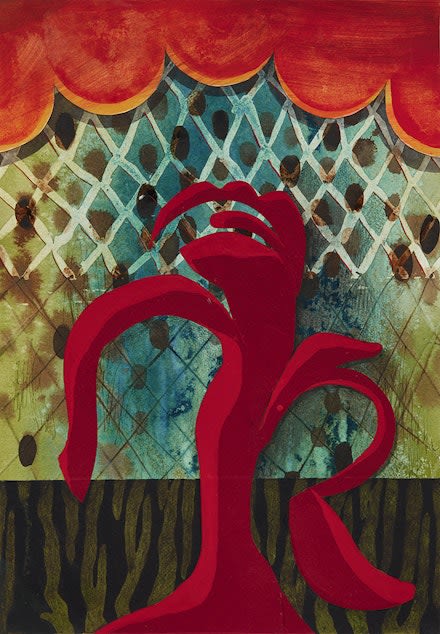In fifteen mixed-media collages on view now at DC Moore, Carrie Moyer shifts the boisterous abstract compositions for which she’s renowned to a smaller, more personal scale. Occupying one of the gallery’s back spaces, this exhibition, titled Morphologies, is in many ways a continuation of longstanding concerns. Moyer’s sense of formal design remains tenaciously eccentric, and there’s still a high degree of spatial theatricality in her mischievous illusionism.
Yet with these cut-paper collages, the artist leaves behind some of the rigor that paradoxically characterizes her opulent acrylics. The collages are less luxuriant, but more tactile and pliant. Many of them make use of paper marbling, a technique that dates at least back to tenth-century Japan, was used extensively in medieval Islamic manuscript, and became prominent in nineteenth-century book binding. Created by placing droplets of immiscible inks on a water bath treated with carrageenan (a seaweed extract), then manipulating those inks with pins and combs, marbled papers can be free-flowing kaleidoscopes, like the background of a Roger Corman–inspired acid trip, or meticulously controlled patterns that are nonetheless aqueous and unreproducible.
Of course, paper marbling is only one among many modes of mark-making that Moyer employs in these variegated “arrangements,” as she has titled and numbered the works. In a single small collage (few are larger than two feet to a side) one may find evidence of monotype, other printmaking methods, cut colored papers, and all sorts of watercolor techniques. Nevertheless, the marbling process seems somehow to metaphorize a broad but subtle shift. In the large acrylic paintings that I saw in Moyer’s previous exhibition with the gallery (and to some extent in Giardini [2022], the single painting on view now), the declarative frontality of her hard-edged shapes were set against gushing torrents of downward movement, cascades of flowing pigment that needled received taste and flirted with Color Field decadence. With these collages, Moyer seems to have moved from the sparkling waterfall to the standing-water pond.
As with the best ponds, it’s probably not safe to drink, but there are tons of weird growth and biological diversity. Spots of dark pigment placed wet-into-wet on the paper, bleeding outwards, look like festering molds or ominous cellular nuclei. Sight lines meander about on the surface, and somewhat aimlessly at that. In place of sweeping vivacity is a more circuitous kind of energy, one aligned with the spirit of shifting pieces of paper about a tabletop surface, seen from above.
Sure, there’s still plenty of pizzazz; Moyer doesn’t get stuck in the muck and mire. Along with water, Morphologies makes liberal allusion to the three remaining classical elements—earth, fire, and air—conjuring an alchemical atmosphere. Are the burning-hot flame-like shapes of Arrangement #2 (2021) a play on the biblical “tongues of fire”? Perhaps, but the composition, with its central mass protruding among claustrophobic forms textured with reddish, hairlike wisps, as easily evokes cunnilingus.
Many of her forms even evoke internal anatomy: blood vessels, fallopian tubes, kidneys, uteri, lymph nodes, and more. Only with Arrangement #9 (2021) does Moyer give us something close to a full view of a conventionally scaled figure. Here, a central red form, looking a bit like a wilting flower arrangement, has been anthropomorphized (I imagine) in order to perform, under the spotlight, rather piteously, against the backdrop of a vintage theater stage.
Generally, however, Moyer’s shapes resist settled understanding. It’s difficult to find one’s bearings. Is this at the microbial or astronomical scale? Are we looking down at the dirt, into ocean depths, or up at the sky? In Arrangement #10 (2021), a red ladder runs vertically through the center of the picture against an oceanic background, as if it’s leaning against the glass of an aquarium tank. Each rung incorporates a kind of lunette niche, most of which hold a half-moon of marbled paper. Or is this ladder really not a ladder, but instead a kind of floating bridge, seen from birds-eye view, those half-circles actually full circles that are partially submerged under a watery surface? Best yet, perhaps this is no structure of human engineering at all, but instead that which aspires only to encourage un-busied seeing along labyrinthine lines of thought.
...
Read review at brooklynrail.org.

